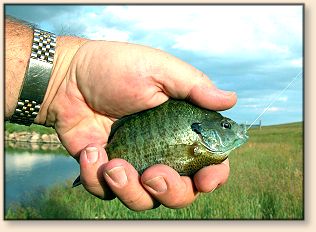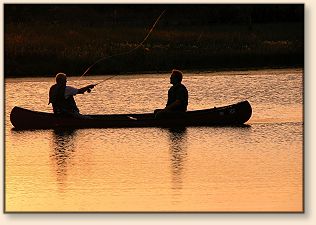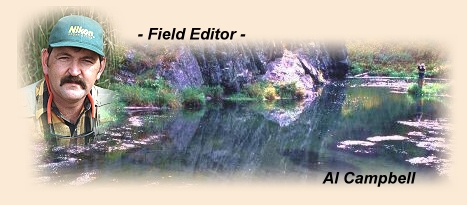|
Why is it that so many writers write about any
exotic body of water they can manage to visit,
but when it concerns their home waters, they are
strangely silent? Is it because they don't want
anybody to invade the water they fish most often?
Maybe they don't want anyone to know where they
really come from?
Another thing I wonder about is; how can a person
be an expert on a body of water if he/she doesn't
fish it often or live near it. A guy who lives in
another state wrote the most publicized and most
popular book on the water near where I live. How
can a guy spend a month or two in an area and suddenly
become an "expert" on that area? Worse yet, some guys
spend only a few days in an area and try to come off
as an expert on that area's fishing. I'm not inclined
to accept their views as expert advice on my area's
waters. Instead I think of them as a limited view
of the outside of a treasure chest I call home
waters. They couldn't possibly know the treasures
that are hidden inside.
I gave up my subscription to a popular fly-fishing magazine
for that reason. They had a lot of good product reviews,
but there was precious little in the way of articles on
fishing close to home. In a year's time I was able to
read about two or three exotic locations in each issue,
but articles on home waters within the continental United
States or southern Canada were extremely rare. Joe from
Chicago goes to Russia and catches big trout and salmon.
He comes back with some great pictures and "expert" advice
on everything from flies and gear to the best times to
fish that area. In the same issue Bob from Dallas goes
to Alaska and returns an "expert" on the salmon fishing
there. Pete from Phoenix rounds off the top three articles
with "expert advice" after his trip to Argentina. But,
where were the articles about fishing we can drive to in
a day?
I won't try to claim innocence here. I have been guilty
of visiting a place where I don't live and writing about
it; and I'll do it again when the opportunity arises.
However, I don't try to pass myself off as an expert on
the waters I visit. I think there is a big difference
there. You get a better feel for an area and you read
more accurate information about that area if the author
lives in or near that area and fishes it often. For
that reason, I tip my hat to Bob Krumm for all the
writing he does about the rivers he guides on.
What is it about home waters that we wish to protect?
Is it a desire to keep the secrets of the water to
ourselves? Do we resent anyone else searching for
an intimacy with our water that is similar to the
intimacy we share with that water? Why are we so
willing to tell all about other people's home waters,
but timid to reveal the same information about our
own home turf? I honestly don't know the answer to
those questions. I just know that it is somehow easier
to share waters other than our own with those who might
want to share that experience.

I think I'm going to try to break that chain. Starting
this week, I'm going to expose some of my home water
and share a few secrets with you. Since it is my home
water, it won't be some quickie from a guy who just
visited the area, but rather a look at the treasures
I hold dear and know well. If I do this right, the
next time you visit my home waters, you'll feel like
you know some of the secrets they hold and it will be
like a reunion with an old friend. At least, that
is my goal.
Last Wednesday I fished a small pond (maybe 80 acres)
with a couple of my friends. The pond is owned by one
of those friends, so it isn't accessible to everyone,
and I won't reveal its exact location. However, it is
very typical of the small lakes and ponds in my area,
so the flavor of this water relates to other waters
close by and easily accessible to the public.
This pond, like most of the ponds and small lakes on
the western South Dakota prairie, is loaded with small
to medium sized largemouth bass, bluegills and crappies.
Yellow-belly bullheads search the bottom for anything
that is edible and are easy targets for anyone fishing
with a worm or dough ball. Although this pond is private,
I have fished dozens of other public ponds and lakes like
it with names like New Underwood, New Wall, Wicksville,
Tisdale, Howes, Newell and Cottonwood. They all fish
much the same, and they are all "home waters" to me.
Dragonflies and damselflies are the main insect hatches
on these lakes, but other insects exist in numbers strong
enough to vary the diets of the fish and keep them interested
in other offerings. A fairly heavy evening hatch of tricos
had the bluegills hopping, and the bass were slipping into
the shallow water to feast on small fish searching the
surface for a meal. That is a typical summer evening
on this and the other ponds and lakes on our prairie
landscape.
Except for the area near the earthen dam, the shallow
areas near the shoreline of most of the pond are covered
with a heavy mat of weeds by mid June. It's the same
thing on the other small waters in our area. Without
a boat, canoe, personal pontoon or float tube, the
shallow areas of the lake would be un-fishable. Fred
brought a canoe, so he and Bob hunted the upper reaches
of the pond while Mike and I picked on the bluegills
near the dam.
Bob is a novice fly fisherman who is learning the trade,
so his casting distance was limited. He'll learn it fast.
We won't let him backslide into the spinning gear now.
I don't think he would slip that direction anyway. He
had too much fun with the fly rod. Home waters are a
perfect place to learn new techniques and new ways of
fishing.

We hooked up with Orange Shwapf's to pester the bluegills
until just before sundown. Small bluegills like this one
and a few up to a pound and a half are
common fare in this area. We caught more 'gills than we
cared to count, and although the owner of the pond invited
us to take a bunch home for some fine eating, we were too
busy catching them to entertain the idea of cleaning them,
so they were released to be caught again another day.
As the sun prepared to set on the western horizon, I
switched to a yellow marabou muddler and started catching
bass in the two-pound range. There are bigger bass in
this and the other local ponds and lakes, but two pounds
is fairly typical of the average size in all these lakes.
That's a nice size for a five or six weight rod. I
landed four bass and lost as many in the 45 minutes
I fished for them.
Something about a sunset over a prairie pond appeals
to my photographic eye. I might have caught more bass
if I hadn't put my fly rod down and picked up my camera
to capture the shades of a setting sun and the silhouette
of two friends in a canoe. Small waters offer views
you can't find everywhere, and life is too short to
miss the scenery, or a colorful sunset.

Crackers with cheese and soft drinks or a beer served up
from the back of a Chevy Blazer were all we needed to cap
a great evening. Sharing home waters with a few good
friends is one of life's greatest treasures. The gold
hues of a setting sun reflected the true treasure of
good friends, good conversation, good fishing and home
waters. ~ AC
|









